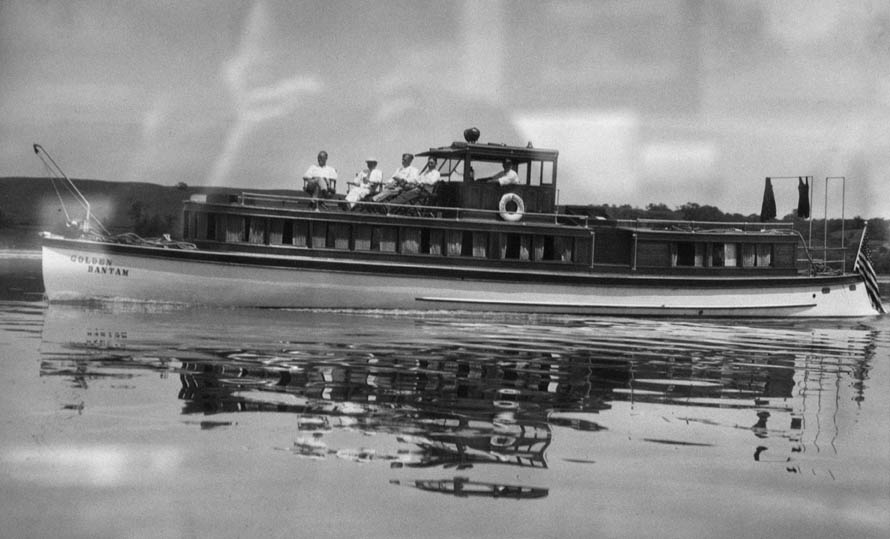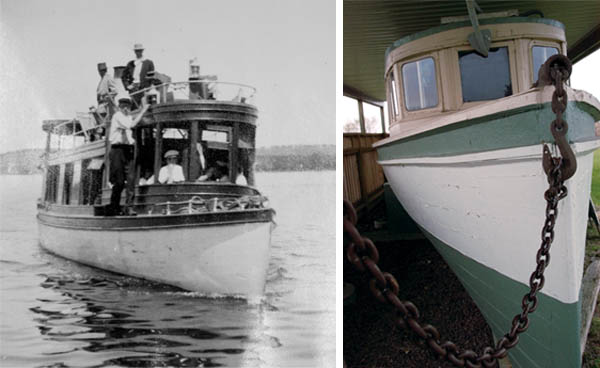The Gift of South Dakota
Subscriptions to South Dakota Magazine make great gifts!
Subscribe today — 1 year (6 issues) is just $29!
The Muskegon Disaster
Remembering a deadly storm on Big Stone Lake
 |
| The Muskegon was hailed as the finest boat ever on Big Stone Lake in 1909. |
Just beyond the South Dakota border in Ortonville, Minn., lies a 100-year-old boat in such fine shape it almost begs for an outing on Big Stone Lake. But 94 years ago, that boat sat battered on the lake, the victim of the worst nautical tragedy in the history of the state.
Nobody paid much attention that infamous day – July 10, 1917 – as the skies grew darker around Big Stone Lake in extreme northeast South Dakota. The nine people who stepped aboard The Muskegon, an excursion boat docked at Hartford Beach, were probably thinking mostly of fun and relaxation. Summertime meant the Chautauqua season was in full swing, and people flocked to see the performances. To transport freight and keep up with the people wanting to attend the Chautauqua, The Muskegon and other boats on Big Stone Lake were busy. Captain Peter Luff of The Muskegon had set off toward the sister cities of Big Stone City and Ortonville, on his second trip of the day.
Rain began to fall as the boat approached the Brick House, about seven miles north of the cities. The crew closed the windows and pulled the side curtains in the back of the boat. Passengers noticed an ominous black ball forming in the sky, and the wind grew stronger. Rain pelted the boat, while wind gusts from the quickly forming tornado created massive waves. As The Muskegon neared Skeleton Island, the wind ripped the flag from the front of the boat and stuck it deep into the island’s rocks.
Eleven-year-old David Mengelt, a passenger on the boat, said the twister appeared to suck the water out of the lake. Crew member Ole Tranberg agreed. “It seemed as if there were two storms and they met right where we were,” he recalled. “On one side it seemed as if the water was all swept away, while on the other side of the boat the water seemed to come at us like a solid wall.” Captain Luff tried to get the boat to shore, but he was no match for the powerful wind and water. The Muskegon capsized.
When The Muskegon first arrived on Big Stone Lake eight years earlier, a local newspaper called it “the handsomest boat ever on Big Stone Lake.” It was built by Minneapolis millionaire Tom Shevlin and owned by M.W. Savage, who used it mostly as a pleasure boat on Lake Minnetonka. Captain Luff, co-owner of the North Star Boat Line with Fred Sanburn, bought it on a trip to Minneapolis in 1909.
It had a 60-foot hull, an 11-foot beam, a 75-horsepower steam engine and a capacity of 150. It was fully cabined and was finished in handsome mahogany and lush upholstery. The Ortonville Herald Star said the purchase “represents an investment that demonstrated the faith that Messrs Sanburn and Luff have in the lake business.” Now, the finest boat to ever cruise Big Stone’s waters was being torn apart.
After The Muskegon turned over, Tranberg crawled on top of the boat. He saw Captain Luff and passenger Albert Nelson in the water. He called for them to follow him to shore. “I grabbed Albert and pulled him toward the boat but the waves tore him from me,” Tranberg remembered. “Again I got hold of him only to meet with the same success. I turned around to look for Pete but he was not in sight. Albert seemed to have no strength with which to help himself and he disappeared.”
Tranberg returned to the boat and saw Mengelt through a window. After several tries, Tranberg finally pulled the unresponsive boy from the wreckage. “At first there seemed to be no life, but after working with him for several minutes he became conscious,” Tranberg said. “I told him to hold onto the boat and I grabbed a couple of life preservers. One of these I put on the boy and told him to hold onto the boat, that I was going to start for shore and if I got there would return to him; if not some one else would come and get him. I started for shore. At first I could not see land but after being in the water for some time sighted it and after swimming for what seemed to be an hour, I landed on Manhattan Island. Going to Cap Day’s house, I notified the authorities at Ortonville. Then I got a launch and returned for the boy, who was badly chilled from exposure.”
Soon rescue boats from Ortonville arrived. They pulled two bodies from the cabin, but persistent rain and wind made further recovery efforts impossible. The next day about 50 volunteers hauled The Muskegon to shore. They searched the hull for bodies, but found none. Volunteers continued the search on Thursday. By 5:30 p.m., all the bodies had been found. The story written for the July 12 issue of the Ortonville Journal reported the bodies were still missing, but shortly before it went to press editors squeezed in an update informing readers of the news.
Among the dead were Albert Nelson; Patrick Weatherly, a boy from Ortonville; Isabelle Larson, of Ortonville; Larson’s two nieces, Bessie and Hazel Erickson, of Audubon, Minn.; Barney Sweeney, a local barber; and Captain Luff. When searchers found Luff’s body his pockets were full of silver dollars he had collected from the passengers.
 |
| After the 1917 disaster, The Muskegon was towed ashore, restored and returned to the lake. Today it is dry-docked near the Big Stone County Museum in Ortonville. |
There had been other shipwrecks on the 26-mile-long lake that separates northeastern South Dakota from western Minnesota, but none as devastating as The Muskegon’s demise. The event had an impact on C.F. Foster, who wrote a song memorializing the boat shortly after the wreck:
Out from the port of Hartford
Down past Sylvan Beach
Gliding across the water
Ortonville for to reach
Born by the gentle breezes
Caught in that terrible gale
Cometh a voice of mourning
A sad and mournful wale
Staunch was that boat Muskegon
Precious the freight she bore
Gaily she loosed the anchor
Less than an hour before
Gaily she swept the harbor
Joyful she rang her bell
Little thought we of sunset
It was told so sad and nil
Oh! ‘Twas the cry of children
Weeping for father gone
Children so gay in the morning
Fatherless at the set of sun
Mothers for husbands weeping
Brothers also likewise
Those were the ties severed
In those seven people’s lives
Lost on this boat Muskegon
Sinking to rise no more
Number of death seven people
Who failed to reach the shore.
Despite the finality of Foster’s song, The Muskegon did rise again. After the wreck the boat was towed to a livery at Big Stone City, where it remained in storage for many years. In October 1927, Frank Douthitt, owner of the Big Stone Canning Company, added The Muskegon to his fleet of boats. The Big Stone Headlight reported that two locals – Joe Creese and Jack Luff – planned to spend the winter reconditioning the boat. “The Muskegon has been in storage for a number of years but is in pretty good shape, and when Joe gets through with her, she will be like new,” the paper said.
Under Creese’s guidance, workers spent the next two years rebuilding The Muskegon. They removed the old steam engine and lowered the deck to make it more stable. Renamed The Golden Bantam, it was officially christened and launched from the Creese Boat Yard in June 1930.
The Golden Bantam was roughly the same size as The Muskegon and was “staunchly built and finely tuned in every respect,” according to the Big Stone Headlight. Finished in mahogany and oak, it boasted electric lights and three compartments with velvet seats that could be turned into bunks. “Every convenience that can be found at home is present on the craft,” the Headlight said, including toilets, a stove, cupboards and a refrigerator. Appropriately, the paper called it the “finest craft ever seen” on Big Stone Lake. Not everyone could enjoy The Golden Bantam’s amenities, though. The boat was for Douthitt’s private use only.
The Golden Bantam cruised Big Stone Lake for the next 30 years. In 1960, the boat was placed in dry-dock north of Big Stone City and was used as a lake cabin. In 1985, it was donated to the Big Stone County Historical Society and Museum, which already had a significant exhibit of Muskegon photos, artifacts and old news articles.
Today the boat is docked outside the museum, a scant few hundred yards from the lake. Freshly painted and well preserved, it looks as seaworthy as it did that fateful day in 1917.
EDITOR'S NOTE – This story is revised from the May/June 2008 issue of South Dakota Magazine. To order this back issue or to subscribe, call 800-456-5117.










Comments